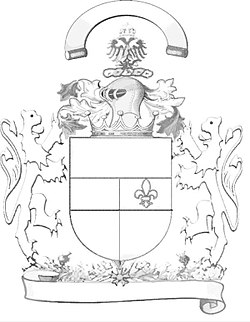Motto
| Part of a series on |
Heraldic achievement |
|---|
Conventional elements of coats of arms |
Escutcheon Chief Field (Tincture) Division Supporter Supporter Slogan (battle cry) Crest Torse Mantling Helmet/Galero Crown/Coronet Compartment Order Ordinaries Charges Motto Dexter Sinister (right) (left)
|
A motto (derived from the Latin muttum, 'mutter', by way of Italian motto, 'word', 'sentence')[1][2][3] is a maxim; a phrase meant to formally summarize the general motivation or intention of an individual, family, social group or organization.[2][3] Mottos are usually found predominantly in written form (unlike slogans, which may also be expressed orally), and may stem from long traditions of social foundations, or from significant events, such as a civil war or a revolution. A motto may be in any language, but Latin has been widely used, especially in the Western world.
Contents
1 Heraldry
2 Literature
3 See also
4 References
Heraldry
In heraldry, a motto is often found below the shield in a banderole; this placement stems from the Middle Ages, in which the vast majority of nobles possessed a coat of arms and a motto. In the case of Scottish heraldry it is mandated to appear above the crest.[4]Spanish coats of arms may display a motto in the bordure of the shield.[5] In heraldic literature, the terms "rallying cry" respectively "battle banner" are also common, which date back to the battle cry, and is usually located above the coat of arms.
In English heraldry mottos are not granted with armorial bearings, and may be adopted and changed at will. In Scottish heraldry, mottos can only be changed by re-matriculation, with the Lord Lyon King of Arms.[6] Although very unusual and perhaps outside standard heraldic practice, there are some examples of the particular appearance of the motto scroll and letters thereon being blazoned;[7] a prominent example is the obverse of the Great Seal of the United States (which is a coat of arms and follows heraldic conventions), the blazon for which specifies that the motto scroll is held in the beak of the bald eagle serving as the escutcheon's supporter.
Ships and submarines in the Royal Navy each have a badge and motto, as do units of the Royal Air Force.[8]
Latin has been very common for mottos, but for nation states their official language is generally chosen. Examples of unusual choices in motto language include:
County of Somerset, Sumorsaete ealle (All men of Somerset), Anglo-Saxon;[9][10]
South Cambridgeshire in the English Fens, Niet Zonder Arbyt (Not Without Labour), Dutch;[11][12]
South Africa, ǃke e: ǀxarra ǁke (Unity in diversity), ǀXam.

Kiribati's motto, Te mauri, te raoi ao te tabomoa (Health, peace and prosperity)
A canting motto is one that contains word play.[13] For example, the motto of the Earl of Onslow is Festina lente, punningly interpreting on-slow (literally "make haste slowly").[14] Similarly, the motto of the Burgh of Tayport: Te oportet alte ferri – "It is incumbent on you to carry yourself high" – is actually a rather terrible cant on: Tayport at auld Tay Ferry, also alluding to the local lighthouse.[15]
Literature
In literature, a motto is a sentence, phrase, poem, or word prefixed to an essay, chapter, novel, or the like suggestive of its subject matter. It is a short, suggestive expression of a guiding principle for the written material that follows.[3]
For example, Robert Louis Stevenson's Travels with a Donkey in the Cévennes uses mottos at the start of each section.[16]
See also
- Epigram
- Hendiatris
- Inscription
- List of Latin phrases
- List of mottos
- List of national mottos
- Slogan
- Tagline
- United in diversity
- United we stand, divided we fall
References
^ "Motto". Merriam-Webster. Retrieved 31 January 2011..mw-parser-output cite.citationfont-style:inherit.mw-parser-output qquotes:"""""""'""'".mw-parser-output code.cs1-codecolor:inherit;background:inherit;border:inherit;padding:inherit.mw-parser-output .cs1-lock-free abackground:url("//upload.wikimedia.org/wikipedia/commons/thumb/6/65/Lock-green.svg/9px-Lock-green.svg.png")no-repeat;background-position:right .1em center.mw-parser-output .cs1-lock-limited a,.mw-parser-output .cs1-lock-registration abackground:url("//upload.wikimedia.org/wikipedia/commons/thumb/d/d6/Lock-gray-alt-2.svg/9px-Lock-gray-alt-2.svg.png")no-repeat;background-position:right .1em center.mw-parser-output .cs1-lock-subscription abackground:url("//upload.wikimedia.org/wikipedia/commons/thumb/a/aa/Lock-red-alt-2.svg/9px-Lock-red-alt-2.svg.png")no-repeat;background-position:right .1em center.mw-parser-output .cs1-subscription,.mw-parser-output .cs1-registrationcolor:#555.mw-parser-output .cs1-subscription span,.mw-parser-output .cs1-registration spanborder-bottom:1px dotted;cursor:help.mw-parser-output .cs1-hidden-errordisplay:none;font-size:100%.mw-parser-output .cs1-visible-errorfont-size:100%.mw-parser-output .cs1-subscription,.mw-parser-output .cs1-registration,.mw-parser-output .cs1-formatfont-size:95%.mw-parser-output .cs1-kern-left,.mw-parser-output .cs1-kern-wl-leftpadding-left:0.2em.mw-parser-output .cs1-kern-right,.mw-parser-output .cs1-kern-wl-rightpadding-right:0.2em
^ ab "Motto". Oxford University Press. Retrieved 31 January 2011.
^ abc "Webster's Revised Unabridged Dictionary (1913)". The ARTFL Project. The University of Chicago. Retrieved 20 December 2013.
^ Von Volborth, Carl-Alexander (March 1980). Heraldry of the World. Blandford Pr. p. 192.
^ Von Volborth, Carl-Alexander (March 1980). Heraldry of the World. Blandford Pr. p. 211.
^ Innes-Smith, Robert (1990). An Outline of Heraldry in England and Scotland. Pilgrim Press. p. 14. ISBN 0-900594-82-9.Mottos are not necessarily hereditary and can be adopted and changed at will.
^ "USS Winston S. Churchill (DDG-81)". Archived from the original on 2007-10-10. Retrieved 2007-10-23.
^ Cassells, Vic (2000). The capital ships: Their battles and their badges. Kangaroo Press. p. 190.
^ "The Danish Invasions". Somerset County Council archives. Retrieved 26 June 2015.
^ "Somerset - Coat of arms (crest) of Somerset".
^ "Civic Heraldry of England and Wales – East Anglia and Essex Area". civicheraldry.co.uk. Retrieved 8 November 2009.
^ "South Cambridgeshire". Rural Services Network. Retrieved 21 December 2013.
^ The manual of heraldry : being a concise description of the several terms used, and containing a dictionary of every designation in the science. Illustrated by four hundred engravings on wood (5th ed.). Arthur Hall, Virtue & Co. 1800. p. 132. Retrieved 21 December 2013.
^ Mark Antony Lower (1860), "Onslow", Patronymica Britannica
^ "Tayport - Coat of arms (crest) of Tayport".
^ Stevenson, Robert Louis (1907). Travels with a Donkey in the Cevennes. London: Chatto & Windus.
| Wikimedia Commons has media related to Mottos. |
| Look up motto in Wiktionary, the free dictionary. |

